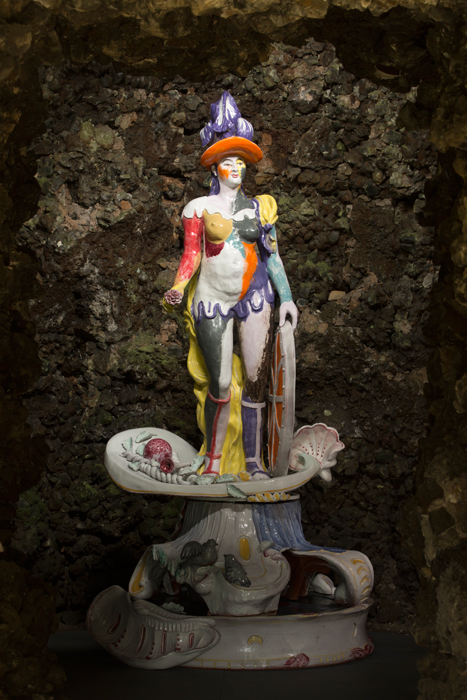A quick Google search for Chatsworth House, in Derbyshire, suggests that the most asked question Googlers have in relation to the ancient seat of the Duke of Devonshire is: ‘What was filmed here?’ Proof perhaps that today Britain’s stately homes, no longer the centres or rural life and national power that they once were, exist most purely in the realm of fantasy rather than reality. But of course, this was always the case. The original house and garden were constructed during the Elizabethan era and featured a flurry of terraces, walled gardens, fountains and ponds. And over the centuries that confection has been continuously refined, expanded and reconstructed. During the eighteenth century the estate was manicured by Capability Brown to create a then-fashionable ideal of a ‘natural’ environment: vistas derived from history painting and trees imported from the US. So perhaps it’s in the spirit of tradition as much as innovation that fashion, fantasy, art and America are at the heart of the latest transformation of Chatsworth’s grounds.
American Rachel Feinstein is the first artist in residence on the estate, as part of a collaboration between Chatsworth and the Gucci fashion house. It’s the latest iteration of Gucci’s expanding engagement with the visual arts (which has included the staging of last year’s Maurizio Cattelan-curated exhibition The Artist is Present at the Yuz Museum in Shanghai, and support of the Italian Pavilion at this year’s Venice Biennale) that focuses on cross-disciplinary sources of inspiration. In keeping with that, Chatsworth is the first of Gucci Creative Director Alessandro Michele’s ‘Gucci Places’, a series of sites around the world (accessible also via an app) that have inspired the fashion house (Chatsworth was the location for Gucci’s Cruise 2017 advertising campaign) and that it, in turn, wishes to open up for exploration by a general public.
Having done her residing during the summer and autumn of last year, this summer Feinstein unveiled two works located in and around Chatsworth’s grotto (constructed at the end of the eighteenth century to look like a mound of boulders and feel, like any fantasy, simultaneously natural and designed) and inspired by the landscape and collections of the estate on which she lived. The powder-coated aluminium sculpture Rococo Hut is part of Feinstein’s Folly series (2014–): a tribute to eighteenth-century fetish for garden follies and, in its theatrical set-like form, a reminder of the role of artifice in the construction of every worldview. It’s a mood-setter perhaps for the main event, which, in turn, appears in Chatsworth’s own grotto-folly in the form of a ceramic sculpture of Britannia, reminiscent simultaneously of Renaissance representations of Venus, a character from one of Watteau’s fêtes gallants, and an enlarged version of the kind of biscuitware sculptures of classical deities or more lurid ceramic representations of neoclassical iconography that littered well-to-do domestic interiors in eighteenth-century Britain, not least Chatsworth. There’s a clear sense of eternal returns.

Britannia was the Roman name for Great Britain and later (during the second century CE) personified in the form a goddess armed with a trident, clad in flowing robes and sporting a Corinthian helmet and shield. By the nineteenth century, as the British Empire took shape, she’d added a lion to her arsenal. There’s nothing native to the iconography, but what could be more British than all that? (Don’t tell the Brexiteers!) Feinstein’s version, while suitably neoclassical is equally expressionistic, with bright, harlequin colours dripping off Britannia’s theatrically dressed body (the colours inspired by a rainbow Gucci dress, the form by pre-Imperial representations of a less martial, more feminine Britannia) and her helmet replaced by a feathered hat, as she strides out of a rococo shell, the fruits of the land sitting where more traditional representations would normally depict the spoils of war. Half-coloured, leaning forward, there’s something mutant about this Britannia: she looks as if she’s becoming something rather than representing anything. Ghostly and decadent, out of time, but somehow in place, a regressive dream from Britain’s past emerging like a fashion-conscious hermit from a musty cave.
Ultimately where Feinstein most succeeds is in the way in which she encourages two simultaneous readings the work: the first as a tribute to the diverse and fantastic formal creations that have passed into Chatsworth over time and space; the second as an artificial structure housed in an artificial geology, in an artificial landscape, representing an artificial ideal of an artificial place. Ironically, it’s the last of course, that most reflects this country’s contemporary reality, its modern folly.
Rococo Hut and Britannia are on public display in Chatsworth Gardens for the next five years
Online exclusive, 19 July 2019
